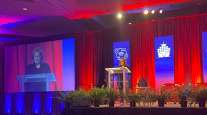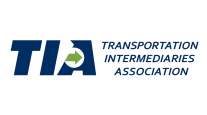Intermodal Stakeholders Advance Ideas to Minimize Terminal Delays for Truckers

FORT LAUDERDALE, Fla. — Several proposals, ranging from mobile apps to chassis pools and ownership, are being advanced to help truckers cope with ongoing intermodal terminal congestion and delays.
Attendees of the Intermodal Association of North America’s annual expo here considered the options late last month as industry stakeholders everywhere search for the right solutions.
Drayage fleet executives re-counted ongoing matters such as waits of up to six hours in terminals, chassis operational and maintenance issues and the financial consequences delays bring.
“There is now a maritime-ports industrywide recognition” that drayage drivers’ working environment and compensation need to be upgraded, said Curtis Whalen, executive director of the Intermodal Motor Carriers Conference at American Trucking Associations.
But David Manning, president of drayage fleet owner TCW Inc., said if carriers supplied chassis 100% of the time, there would be no shortage. “We would figure out how to manage them if we didn’t have to straddle the fence and provide the chassis some of the time but not others,” he said. “Nobody is in charge now.”
Manning also leads the North American Cooperative Chassis Pool, which is controlled by truckers, and is a vice chairman of ATA.
“We have to be solutions-oriented. We have to make sure drivers get the necessary returns [on investment],” XPO Drayage President Hans Stig Moller said. “If you have your own chassis, you shouldn’t be held up.”
XPO (formerly Bridge Terminal Transport) and other drayage carriers have invested in their own chassis. So have groups such as the Harbor Trucking Association.
However, leasing companies provide about 85% of the chassis, said Steve Rubin, president of ITS Technologies & Logistics.
Jerri Parks, director of intermodal for Norfolk Southern Railway, described what is thought to be the rail industry’s first mobile app targeted to intermodal truckers.
Drivers can use the Norfolk Southern app for reservations, equipment and paperwork — giving the railroad and the driver faster access to information.
“We can use that data to attack” terminal issues, she said.
The app was rolled out earlier this year in Atlanta, with a target to offer it at all 52 terminals this year. Most drivers like the application, Parks said, which has cut about 10 minutes out of terminal time.
BNSF Railway is developing an app while Union Pacific Railroad doesn’t have one. CSX Transportation didn’t respond. The executives from BNSF and Union Pacific stressed steps taken to improve chassis quality, driver treatment and terminal operating efficiency.
As for chassis pools, Noel Hacegaba, chief commercial officer at the Port of Long Beach, California, reported a 40% increase in chassis availability and a 20% reduction in truckers’ terminal time since a pool began in March.
The pool, with its 85,000 chassis, helps to prepare for handling ever-larger ships by better managing inventory. “We had very little visibility [of chassis] before,” he said. “It is amazing to see how much improvement has occurred.”
Off-terminal chassis storage facilities, which have been used on both coasts, is another option offered.
James Newsome, CEO of the South Carolina Ports Authority, addressed yet another option: appointment systems to give drivers more precise gate arrivals.
“We would prefer to get predictability of the work on the next day,” he said, because that would improve efficiency.
Darren Edwards, a local trucker in Chicago for Schneider, offered a combination of self-help and timing improvements. Some rail terminals are short-staffed during shift changes, he said, noting that he carries extra supplies, such as lights, to fix minor problems himself instead of waiting in a repair line.
Financial effects of terminal inefficiency were outlined, too. A coalition including shippers and carriers has asked the Federal Maritime Commission to address such drayage issues as detention fees. And others were vocal about the losses resulting from terminal inefficiency.
“We need to be the one that carriers want to do business with, so we don’t keep drivers sitting around,” said Denis Marion, director of U.S. transportation for LG Electronics. Faster trips for drivers might help LG get better rates, he hinted.
Officials from Universal Intermodal Services and Roadrunner Intermodal Services said they link driver treatment with future customers relationships, particularly at a time when drivers are in short supply.
“There are places where we have said we won’t go back there” because drivers are abused, Manning said.
Robert Curry, president of California Multimodal, noted that his company has “fired” shippers that mistreat drivers.




